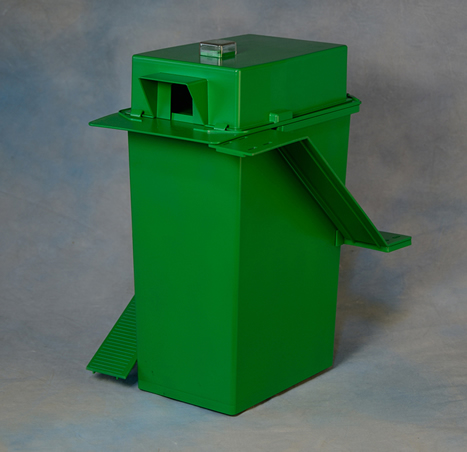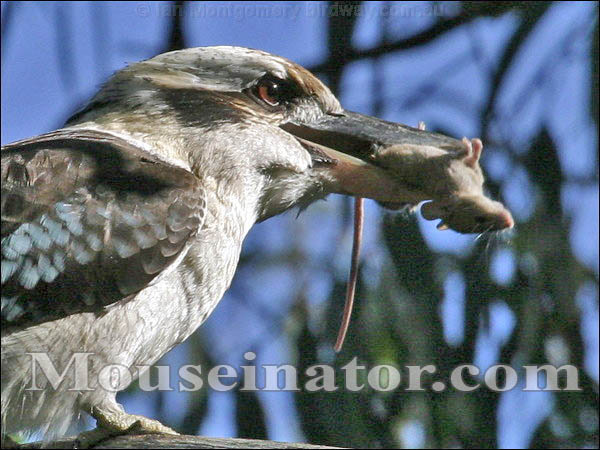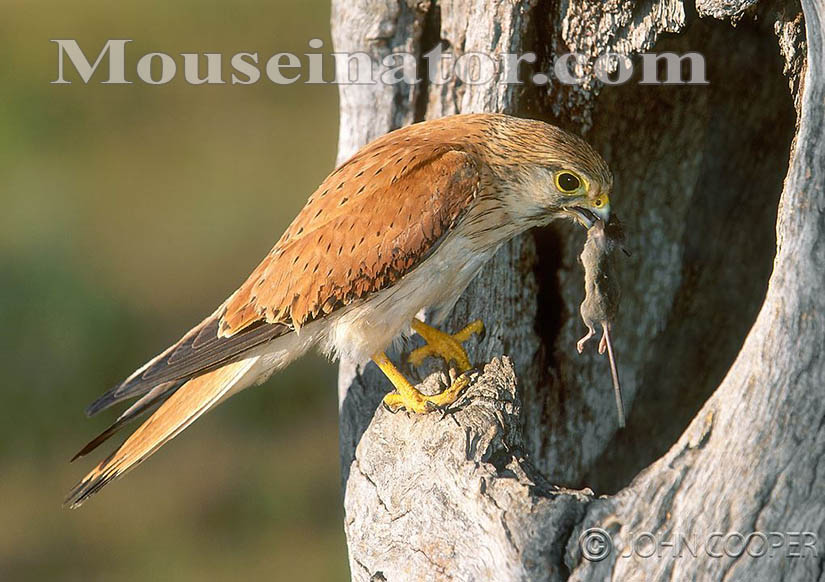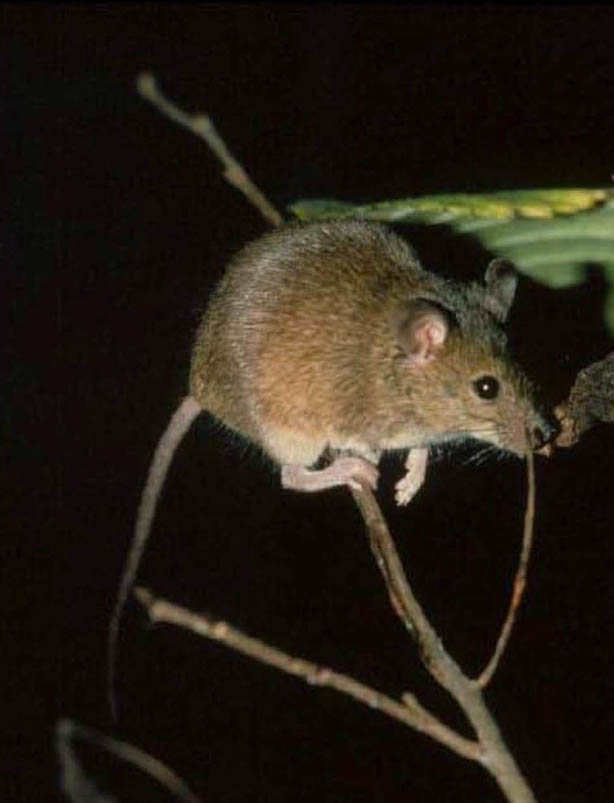Native animals and family pets are at risk from ingesting toxic mouse baits. Using the Mouseinator eliminates this hazard.
Following their arrival in Australia, introduced rodents have posed detrimental impacts on native Australian fauna. Native marsupials and rodents such as the Antechinus and New Holland Mouse have become diminished in population size and have experienced a contracted distribution as a result of the increased competition with the house mouse. According to the Australian Government Canberra in their 1995 publication Action Plan for Australian Rodents "rodents account for hald of Australia's mammal extinction since European settlement" indicating the dire situation of our native species whose survival is further jeopardised by the continued use of toxic baiting. On islands where house mice have been introduced, seabird colonies are often effected as their eggs (and sometimes chicks) are eaten by the mice. Secondary poisoning of birds, particularly raptors but also Magpie, Butcherbirds, Curlews and Kookaburra is a significant concern. Bird-keepers are also detrimented by problematic rodents which spoil seed, feast on eggs and attract snakes to their aviaries. During Rodent plagues well known native predators such as the Kite, Kestrel, Falcon and Hobby species will congregate and feed almost exclusively off mice as they are easy prey in such numbers, as a result of this many raptor unwittingly ingest baited mice and hence succumb to the same fate as their prey. During these times it is not uncommon for wildlife carers to witness raptors and the like being regularly bought in and dying from ingesting baited mice. Reptiles are additionally known to suffer from ingesting poisoned baits or poisoned animals as many of the current poisonous baits appear to be target specific and hence may be taken by wildlife, livestock and pets.
|
By using the Mouseinator you will be contributing to the possibility of a large scale reduction of toxic chemicals within our environment and food chain. Your purchase will greatly diminish the suffering of the rodents that traditional poisonous products inflict. Long term you will be saving on the costs involved in regular baiting, catching, and disposal not to mention reducing the possibility of disease around your home, business or farm or workplace.
We hope you will join us in the movement to decrease the suffering of pest, native and domestic animals by reducing unnecessary toxic baits and their role in our food chain.

Mouseinator is a revolutionary invention that allows the trapping and humane destruction of multiple rodents, eliminating secondary poisoning of native animals and pets as it uses no toxic chemicals to operate. The captured pests are destroyed and contained within the unit for easy disposal reducing the incidence of dead rodents in wall cavities or cupboards etc around the home or farm etc. There is no energy source required and as it operates and resets automatically ...................
Following their arrival in Australia, introduced rodents have posed detrimental impacts on native Australian fauna. Native marsupials and rodents such as the Antechinus and New Holland Mouse have become diminished in population size and have experienced a contracted distribution as a result of the increased competition with the house mouse. According to the Australian Government Canberra in their 1995 publication Action Plan for Australian Rodents "rodents account for half of Australia's mammal extinction since European settlement" indicating the dire situation of our native species whose survival is further jeopardised by the continued use of toxic baiting. On islands where house mice have been introduced, seabird colonies are often effected as their eggs (and sometimes chicks) are eaten by the mice. Secondary poisoning of birds, particularly raptors but also Magpie, Butcherbirds, Curlews and Kookaburra is a significant concern. Bird-keepers are also detrimented by problematic rodents which spoil seed, feast on eggs and attract snakes to their aviaries. During Rodent plagues well known native predators such as the Kite, Kestrel, Falcon and Hobby species will congregate and feed almost exclusively off mice as they are easy prey in such numbers, as a result of this many raptor unwittingly ingest baited mice and hence succumb to the same fate as their prey. During these times it is not uncommon for wildlife carers to witness raptors and the like being regularly bought in and dying from ingesting baited mice. Reptiles are additionally known to suffer from ingesting poisoned baits or poisoned animals as many of the current poisonous baits appear to be target specific and hence may be taken by wildlife, livestock and pets.

A Kookaburra eating a mouse. Photo by Ian Montgommery

A Nankeen Kestrel feeding young in a nesting hollow. Photo by John Cooper
The Mouseinator is aimed at reducing the suffering of native animals and mice due to the reduction of poisonous baiting. It is also designed to reduce toxic chemical use in the food chain. Native animals and pets should be further protected by the elimination of secondary poisoning with this device. This should impact on the environment in a positive way as well give an optimistic outlook that as individuals we can make a positive contribution to the world our future generations will inherit.
WHY SUPPORT THIS PRODUCT -
Mice can cause considerable damage to the environment and with the toxic methods currently being used to control their numbers there is risk to secondary poisoning of native species and pets as well as toxic substances being introduced into the food chain. These methods are also not particularly humane and do not reflect most community expectations of how animals should be treated during control of their numbers by human intervention.
According to a University of Nebraska publication for the United States Department of Agriculture Wildlife Research Centre by Gary Witmer and William Pitt "Invasive Rodents in the United States'-
"House mice are native to southern Europe, northern Africa and Asia. They now occur worldwide, including Antarctica, and are probably the most numerous and widespread mammalian species in the world next to humans. While house mice originated in the grasslands of Central Asia, they have followed humans around the world as stowaways on ships. They are very good invaders and probably reached to most parts of the world as stowaways on ships and cargo. House mice have remarkable abilities that have allowed them to be highly successful in many habitats around the world. Chief among these are their reproductive potential and their adaptability in different environments.
House mice are small, slender rodents with fur that is grayish brown above and gray to buff underneath. This small (maximum mass of about 20 g for adults) and highly prolific animal is a continuous breeder in many situations; a female can produce 5-10 litters, each with 5-6 young, per year. The young mature within about 3 weeks and soon become reproductively active. House mice are short-lived (generally less than one year) and have high population tum-over. In one study, 20 mice placed in an outdoor enclosure with abundant food, water, and cover, became a population of 2,000 in eight months.

House mice have amazing abilities which allow them to access almost any available areas or resources.
House mice cause many types of damage. A major concern is the consumption and contamination of stored foods; it has been estimated that substantial amounts of stored foods are lost each year in this manner. Mice also consume and contaminate large amounts of livestock feed at animal production facilities. While mice generally live in close proximity to humans, sometimes feral populations occur. In these cases, the mice may damage many types of crops in the field, especially com, cereal grains, and legun1es. Australia has mouse "plagues" periodically resulting in enormous losses to stored crops and crops in the field. In buildings, a mouse infestation can be a considerable nuisance because of the noise, odours, and droppings. More imp01tantly, they damage insulation and wiring. House fires have been caused by mice gnawing electrical wires; likewise, communication systems have been shut down for periods of time resulting in economic losses. Additionally, house mice are susceptible to a large number of disease agents and endo-parasites.
Consequently, they serve as reservoirs and vectors of disease transmission to humans, pets, and livestock. lmportant among these diseases are leptospirosis, plague, salmonella, lymphocytic choriomeningitis, and toxoplasmosis. Finally, when introduced to islands, mice can cause significant damage to natural resources, including both flora and fauna. For example, on Gough Island and, mice fed on nestling albatross chicks . Additionally, Witmer (unpubl. data) documented seedling damage by house mice in a pen study. However, mice are subordinate to introduced rats so the impacts of mice not noticed when rats are also present on the island . This phenomenon was demonstrated by the large increase in mice abundance on Buck Island, USVI, after invasive roof rats were eradicated.
A large number of methods and materials have been developed to help solve house mouse problems. In general, the use of multiple approaches and materials - integrated pest management- is more likely to reduce a mouse problem to a tolerable level . The tools available and their proper use have been extensively reviewed (Brooks, 1973; Prakash, 1988; Timm, 1994b; Corrigan, 2001).
Rodenticides are widely used in the United States as well other parts of the world. Both primary (direct consumption) and secondary hazards (consuming a poisoned rodent or poisoned non-target animal) can occur to non-target animals when rodenticides are used.
Rodenticides such as brodifacoum (a second generation anticoagulant) are highly toxic, but also result in persistent residues in body tissues of animals that consume poisoned rodents
There is a growing concern about the secondary effects of these residues in predatory animals (e.g. , Thomas et aI. , 2011).
Additional research is needed to improve existing methods and to develop new methods for invasive rodent detection and control. More research is needed in both lethal and nonlethal means of resolving rodent damage situations.
A number of challenges remain with invasive rodent management and eradication in the United States. Some of the challenges faced include the public and agency concerns about the use of toxicants and traps, land access (especially to private lands), public attitudes, resource availability, and detection and monitoring difficulties. Nonetheless, we will hopefully continue to relieve the burdens on insular and mainland ec.osystems caused by rodent introductions. The flora and fauna of islands generally respond favourably and rapidly after invasive rodents are removed. Endemic. threatened, or endangered species can be, and have been, re-introduced after successful rodent eradications. For example, the endangered St. Croix ground lizard (Ameiva polops) was recently re introduced to Buck Island in the U.S. Virgin Islands after the successful eradication of roof rats. The recent eradication of Polynesian rats and house mice from Cocos Island (a small island off of Guam) set the stage for the re-introduction of the endangered Guam rail (flightless bird species).
Invasive rodents will continue to pose challenges to land and resource managers, commodity producers, and homeowners. Many tools are available to reduce rodent populations and associated damage. They should be used in a well thought out IPM approach.
Additionally, seabird populations, sea turtle populations and other island resources warrant protection from invasive rodents. The recovery of fauna and flora on uninhabited islands after a successful rodent eradication is particularly notable. The significant impacts of introduced rodents on native flora and fauna have been repeatedly demonstrated. Invasive rodents are very adaptable, can exploit a wide array of resources as food and cover, and can increase reproduction very quickly when and where abundant resources exist. While invasive rodents will continue to pose challenges to land and resource managers, they can be controlled or even eradicated with a well-planned and adequately-supported effort using rodenticides and other tools. With proper planning, non-target losses will be 1ninimal and these populations, along with other island resources, will often recover quickly after the invasive rodents have been removed."
- QUOTED FROM SOURCE "Invasive Rodents in the United States'
NATIVE RODENTS CAN BE CAPTURED AND RELOCATED WITH THIS DEVICE
If you have native rodents that you wish to relocate this device is ideal for this purpose. Just simply capture, identify and relocate to another location !
PLEASE JOIN THE MOUSEINATOR MOVEMENT AND REGISTER YOUR INTEREST HERE -

|